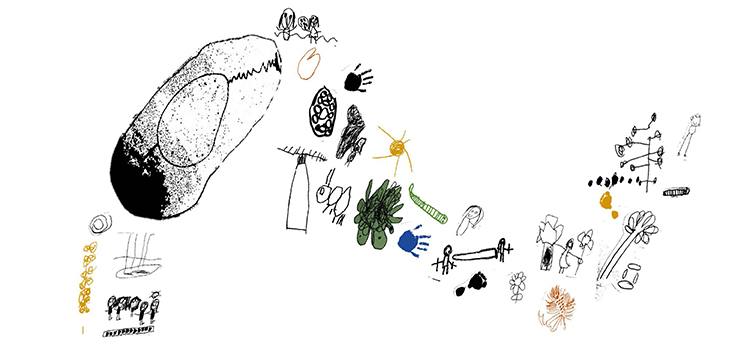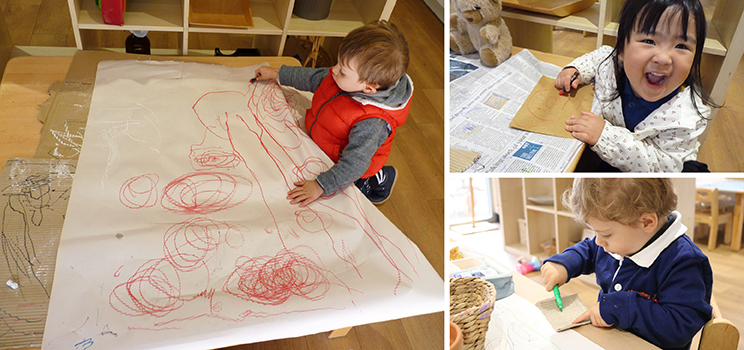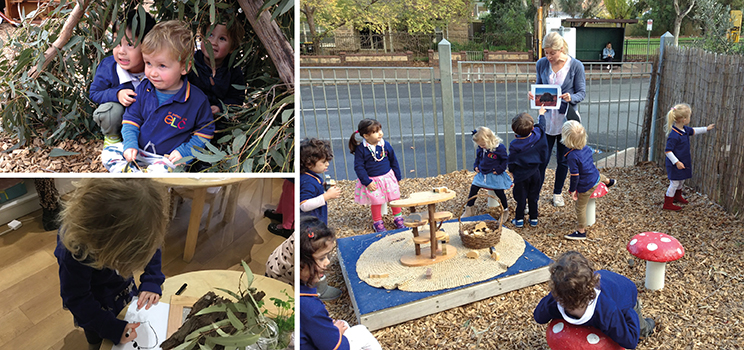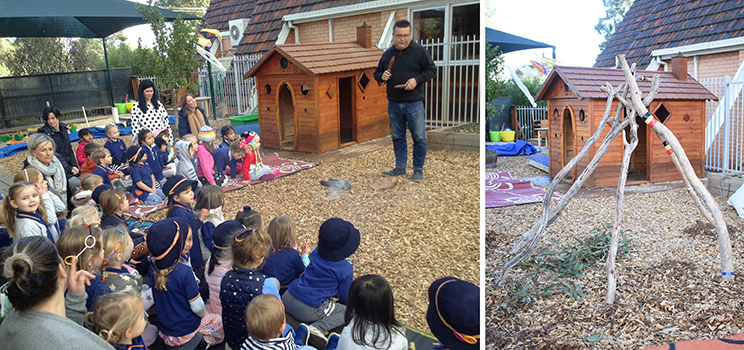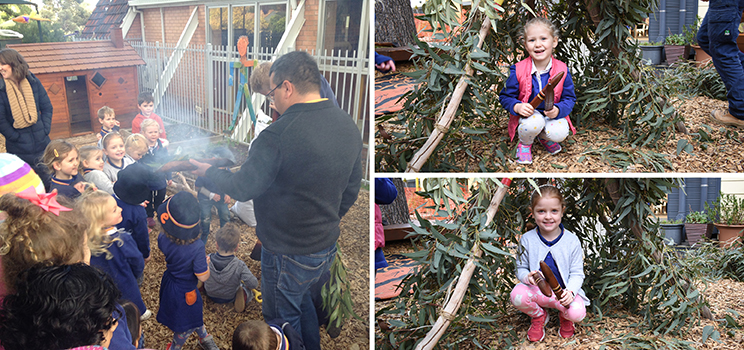From the Director of Early Learning
Dear Families
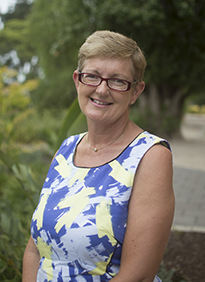
As we enter the final days of the first half of our school year, we reflect on the incredible journey travelled by our young students. We are very proud of the rich learning that is happening in the ELC across all age groups, with highlights including:
- Our ELC Festival
- Several Ferguson Park visits
- Deep inquiries
- Establishment of a strong relationship with Tamaru including Reconciliation Week
- The official opening of our ELC Path
This semester of learning and growing has equipped many of our children with the skills needed for their transitions. You may have read Ms Haddy’s article in eNews focussing on our Mid-Year Receptions who have their final transition visit this week. This is accompanied by several informal visits with preparation for our internal movement next term. It is extremely important that we discuss changes with our children to ensure they are prepared for what the next venture brings. This includes using the names of the educators the children will encounter in their movement.
We understand many of us find change challenging, however, we believe that open communication is a critical step. This can be supported with Vacation Care sessions that will enable children to be in other spaces with a broader scope of educators.
I am available for any conversations around the upcoming changes, so please feel free to stop by my office. We are keen to ensure every child is prepared for Term 3. In addition, I remind you that Mrs Kirsty Porplycia will be Acting Director of Early Learning as I take long service leave in Term 3.
Please read this edition of ELC eNews carefully as it contains many important pieces of information. I send you all best wishes for the school holidays and a wonderful Term 3.
Kind regards
Kate Mount
Director of Early Learning
Have You Applied for the New Child Care Subsidy?
As you may be aware, the government is rolling out a new Child Care Subsidy (CCS) from 2 July 2018.
A few important factors to know:
Information is NOT carried over to the new CCS even if you are already entitled to or claim Child Care Benefit (CCB) or Child Care Rebate (CCR).
You must apply to be assessed for the new CCS via myGov.
If families do not complete their assessment before 2 July 2018, they may not receive any child care fee assistance.
For further information and instructions on how to register for the CCS to ensure you receive your entitlements, click here.
If you have any other queries, please contact our ELC Enrolments and Finance Officer, Sarah Elliott, via 8334 2271 or selliott@stpetersgirls.sa.edu.au and she will be happy to assist.
Save the Date
25 June: ELC Hat Ceremony
2 July: Vacation Care Commences
24 July: Term 3 Commences
We Made a Path for You!
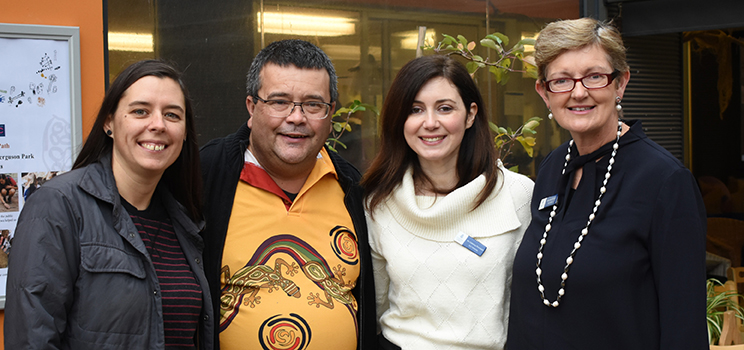
Our path has many meanings for us. Our path is a metaphor for connections.
One connection is with Ferguson Park. It is our special place where nature, learning and culture of our country are merged. A place of encounter for children, educators and families. A place to remember the stories of the past and to create new memories.
Our path is also a symbol of connection between the two ends of our Centre. We have carefully chosen the position of the path to create a link between the new architecture and the older structure of the ELC, the Hallett and Ferguson Rooms.
We created this bridge, this connection, with a public work of art made by a public artist: Christine Cholewa. We chose Christine not because she was an expert in working with children, she had never worked with children and it was not an issue for us. She is a public artist and public artists are working for the citizens to give them voice and a public space to share stories, meanings and metaphors. It was what we were looking for. It was a political choice for our citizens. We have been lucky to find Christine and to share our values with her. She gently let the children’s ideas lead the design of our path and she made real what for the children was just possible. This is the biggest metaphor for us: let the children understand that their dreams, their ideas, their project are valued, are supported and are real.
A path is also a symbol of direction… As educators, we’ve chosen a path of understanding and listening. As a community, you are all participating in our learning. As parents, you chose us as your path and now we all have a common direction. I invite you to look to our path and see all the learning, all the possibilities that a collaboration can bring: we can see our children walking with Tamaru in Ferguson Park looking at golden wattles trees, sitting in a polti circle and listening to kookaburras and then dancing with the trees…These are our stories, our memories, and this is just the beginning of new possibilities.
Caterina Pennestri
ELC Atelierista
Vacation Care
Families are reminded that forms need to be completed by Monday 25 June in order to secure your enrolment in Vacation Care. You can download the Vacation Care booking form here.
Vacation Care is offered every weekday from Monday 2 July to Monday 23 July. Term 3 commences on Tuesday 24 July.
St Peter’s Girls’ School: Mid-Year Reception Transition
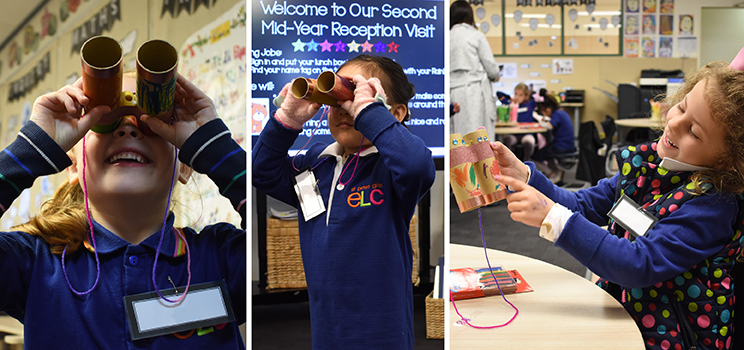
“As children make transitions to new settings (including school), educators from early childhood settings and schools commit to sharing information about each child’s knowledge and skills so learning can build on foundations of earlier learning. Educators work collaboratively with each child’s new educator and other professionals to ensure a successful transition. In partnership with families, early childhood educators ensure that children have an active role in preparing for transitions.” – The Early Years Learning Framework for Australia
At St Peter’s Girls’ Early Learners’ Centre, we are committed to ensuring that any child leaving our community has a smooth transition to their new environment. We feel this is an essential part of a child’s foundation for their education. We aim to work in partnership with the new educational setting; whether it is a school, ELC or kindergarten, where information is communicated to the educators to provide a seamless transition for the child and their family.
Over the past few weeks, girls from the Hallett Room have enjoyed their formal transition visits to the Reception learning community to explore the classrooms and meet their new teacher, Miss Alana Lesiw. During these transition visits, the girls have shown their confidence in engaging with the spaces and resources available.
Many parents commented on the confidence and pure joy on their daughter’s face when they waved goodbye to them from the classroom. This confidence has been built throughout their time in the ELC. The girls’ transition to the ‘big school’ has been carefully and intentionally thought about when they entered the Ferguson and Hallett Rooms, as they engaged in Buddy Sessions, Library visits, specialist programs, Teacher Swaps (with Reception teachers) and attending school assemblies and events.
The girls have shown excitement towards the next step of their learning journey and we can’t wait to visit them next term, as our friends will be dearly missed. We look forward to farewelling our Mid-Year Reception friends at the Hat Ceremony next Monday at the School Assembly.
Kirsty Porplycia
Early Speech and Language Development Information Session
Parents are invited to join us for an engaging information session hosted by Speech Pathologist Jen Robertson.
Monday 25 June
2.15 – 3pm
ELC
The session will cover topics such as:
- How can I encourage the development of my child’s speech and language skills?
- What games and home activities assist learning?
- How can I help my child’s developing literacy skills to be ready for school?
- When should I worry?
A Message from Mrs Yu
亲爱的家长朋友们,
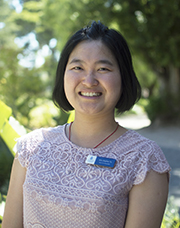
当我们进入本学年上半年的最后两周时,我们反思并庆祝了我们年轻学生旅行的旅程。我们非常自豪于ELC在所有年龄段的丰富学习,包括ELC节日,弗格森公园参观,与Tamaru建立和保持强有力的关系,以及我们ELC路径的建成与开放。
学习和成长的学期为我们的许多孩子配备了过渡所需的技能。您可以阅读哈迪女士在Enews的文章,重点介绍我们的学校的年中学前班。与我们的孩子讨论改变是非常重要的,以确保他们为即将到来的新旅程做好准备。
温馨提醒:假期快到来了,请填写已发布的假期课程表格或从时事通讯下载。假期课程将使儿童能够接触更广泛的的其他空间及认识更多的ELC的教育者。此外,第三期开始时间为七月二十四日星期二 —— 在Kate Mount享有长期服务假期间,Kirsty Porplycia女士将在第三学期担任代理校长 。
如有任何问题,请发送电子邮件至 kmount@stpetersgirls.sa.edu.au 或去校长Kate的办公室面对面聊。Kate女士希望确保每个人都为第三学期做好准备,并为转入小学这改变做好准备。
祝大家七月学校假期愉快,并祝愿你学期快乐!
我的邮箱:syu@stpetersgirls.sa.edu.au
Mrs Sophie Yu
News from the Stonyfell Room
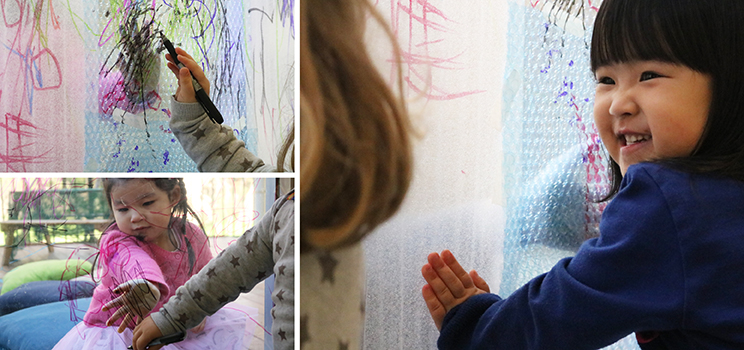
How our point of view can shift our perspective: exploring transparency and opacity through the language of mark-making
Often our children’s perspectives can be different from that of ours as adults. What we believe they might think and know can be altered or changed by their attitude and perspective.
We covered part of a window with materials with different textures and grades of opaqueness. We, as the educators, wanted to challenge the children and allow them to think and explore the different qualities of the materials we had provided. Our intention was to offer the children opaque materials and transparent surfaces to work on, and we wondered how the children would be impacted by these visual changes.
We asked the children:
– Can you see Ferguson Park?
– Can you see your friends?
The answers were all positive:
– Yes, I can see your hand!
– I can see the sky!
Children could see! They could always see even when the visibility was only partial. They can fill the gap between what is missing using their previous knowledge. It is a fundamental cognitive step that makes many other aspects possible in their learning process.
A shadow is enough to recognise the shape of a tree or a friend. Of course, they can see – they know how to observe their world. Their optimistic point of view allows them to process the information that they have and they don’t focus on what is missing.
Laura Reiters
News from the Bell Yett Room
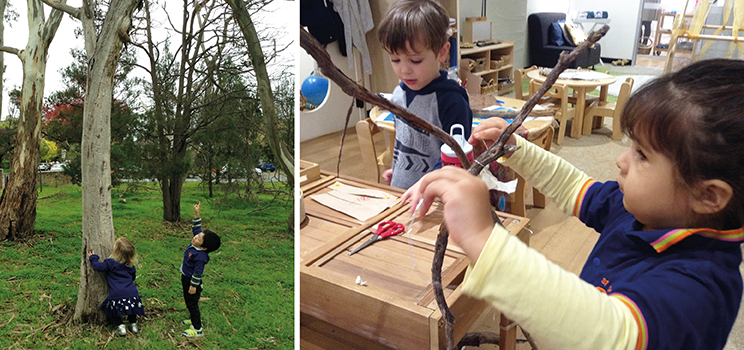
Listening to and understanding the narratives of people and places can enrich our point of view
Through investigating Ferguson Park, we have been intending for the children to:
- Predict what they might see
- Become aware of seasonal changes
- Use photography to enhance observations and graphic representations
- Create a shared narrative of this special place
During Term 2, a small group of children discovered a broken tree in Ferguson Park. They used the iPad to document their findings and returned to share their discovery with their friends.
Over time, we observed the children’s ongoing interest in the broken tree as it continually featured in their conversations, drawing and photographs. They developed many theories as to how the tree broke and how it might be fixed. Within their different ideas, there was one constant: the children all demonstrated a great sense of empathy towards the tree and felt very strongly that it needed to be fixed.
We decided to relaunch this fascination with the broken tree by giving the children the opportunity to ‘fix’ some broken branches we found in Ferguson Park. As the children spent time manipulating wire, tape, and string, they also demonstrated many positive dispositions for learning, such as problem solving, persistence and creativity. They also practised many literacy and numeracy skills as they drew up plans, measured materials, estimated and explored size and shape.
We invite you to spend some time over the mid-year break to view your child’s ePortfolio where you will find a detailed account of your child’s engagement and learning in our inquiry this term.
Leanne Williams and Nell Tierney
News from the Ferguson Room
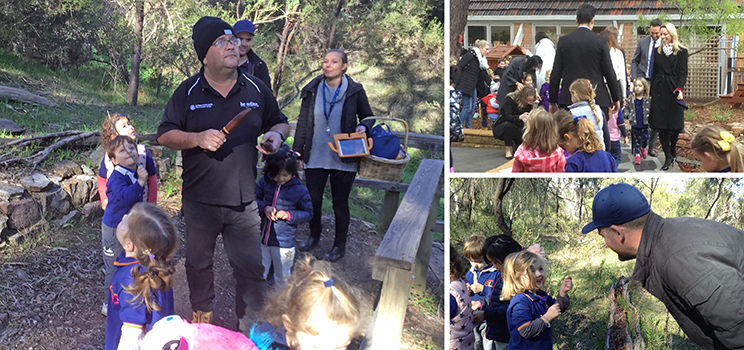
In Term 2, our PYP Central Idea has been: Listening to and understanding the narratives of people and places can enrich our point of view.
Learning to really listen is a skill that transforms our thinking and perspectives. It allows us to be open to differences and recognise the value of another’s interpretation. This term, we have placed great emphasis on listening to one another. In our Essential Agreement, we agree that ‘listening is caring’. We have also greatly valued the knowledge and stories that Tamaru has shared with us on his regular visits throughout the term.
Listening to places has a more spiritual implication, and our daily visits to Ferguson Park have provided the opportunity for us to tune in to the life and indeed the stories of the bushland, filling us with joy, vigour and appreciation for the beautiful world in which we live. Many of our parents have joined us on these visits and have been thrilled to share in the learning with the children. We have added a new element to this concept of listening to places with the unveiling of our ELC path. The images on the path reflect the children’s memories and stories of Ferguson Park, which will continue for future students who will come to live, learn and play here too.
At the end of Term 2, each of the children will have a new ePortfolio piece sharing with you their learning journey throughout the term. We invite you to go online and view your child’s ePortfolio as there will also be new additions to their photo gallery. We are currently busy getting these pieces ready to upload and are excited to share with you the deep engagement of each and every one of our amazing friends in the Ferguson Room.
Mel Angel
News from the Hallett Room
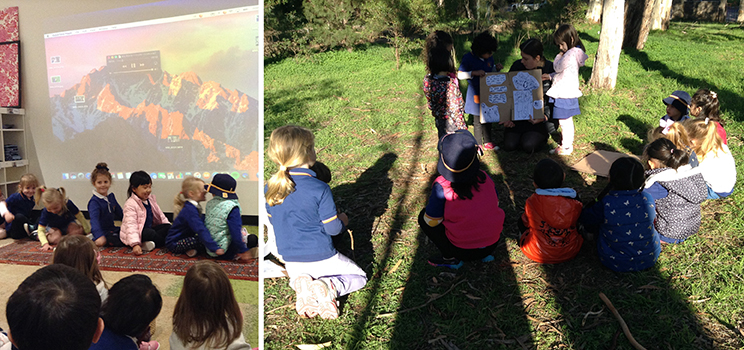
The Hallett Room children love to be the experts. Given they are the oldest students in the ELC, we often see moments where they lead others throughout the day. It is something that we can enhance as the adults. Through our inquiry this term, we promoted the children being the expert through sharing their knowledge of the Reconciliation Story. The collaboration we witnessed during the planning of the stories saw a variety of roles from the children. Some became the director, some could reflect on themselves and others, some simply cherished being part of a group that they had chosen to be a part of.
We question ourselves and ask, what does it do for children’s wellbeing when they can share their knowledge? No matter what sort of personality children have, we see moments during their day where being ‘the expert’ has a direct effect on their positive self-worth. Throughout this term, we have seen it in different moments – during our excursion, transition visits, community times such as the path opening, even during moments at lunch when children open a lid for a friend. Suddenly they realise they are capable, competent children. When we invite them to show others what they know, they understand they have important and valued skills needed for the society they live in. They learn collaboration which involves both listening and sharing, and are being exposed to the important life lesson that a functioning group requires collaboration. Creating citizens who are strong in their belief in themselves, combined with the ability to work together, helps prepare the children for a life of democracy.
We invite you to view the documentation in the Hallett Room showing the group your child was involved with and the stories created by those children. The summary of how your child participated will be uploaded to your child’s ePortfolio at the end of the term.
Pam Reid

